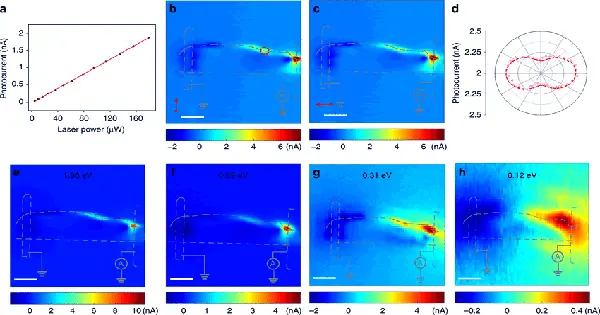Weyl semimetals have a novel mechanism for turning light into electricity, which can be discovered using quantum sensors. Brian Zhou, an assistant professor of physics at Boston College (BC), and colleagues present their findings in the journal Nature Physics.
The conversion of light into electrical impulses is a key component of much contemporary technology, including cameras, fiber optic networks, and solar cells. However, most materials have no preferred direction for the flow of electricity, therefore putting a light on their surface won’t produce any electricity. Researchers are concentrating on Weyl semimetals in an effort to get beyond these restrictions and create new optoelectronic devices because of the peculiar characteristics of their electrons.
The majority of photoelectrical devices, according to Zhou, who collaborated with eight BC colleagues and two researchers from Singapore’s Nanyang Technological University, use two different materials to produce an asymmetry in space. Here, we demonstrated that spontaneous photocurrents can arise from spatial asymmetry within a single material, namely from asymmetry in its thermoelectric transport characteristics.
The researchers investigated the semimetals from the Weyl class known as tantalum iridium tetra telluride and tungsten ditelluride. Due to the fact that these materials’ crystal structures are naturally inversion asymmetric—that is, they do not map onto themselves by reversing orientations around a point—researchers have hypothesized that they might make suitable candidates for photocurrent production.
The goal of Zhou’s research team was to discover why Weyl semimetals are good at turning light into electricity. Similar to measuring the amount of water flowing from a sink into a drainpipe, earlier measures could only quantify the amount of electricity leaving a gadget. Zhou’s team attempted to visualize the electricity flow within the apparatus, much like creating a map of the whirling water currents in the sink, in order to better understand the source of the photocurrents.
Graduate student Yu-Xuan Wang, the manuscript’s lead author, said that as part of the project, “we developed a new method using quantum magnetic field sensors called nitrogen-vacancy centers in diamond to image the local magnetic field produced by the photocurrents and reconstruct the full streamlines of the photocurrent flow.”
Around the area where the light hit the material, the scientists discovered that the electrical current flowed in a four-fold vortex pattern. The team went on to illustrate how the material’s edges affect the circulating flow pattern and found that the precise angle of the edge controls whether the device’s overall photocurrent is positive, negative, or zero.
The photocurrent generation mechanism is surprisingly due to an anisotropic photo thermoelectric effect, or differences in how heat is converted to current along the different in-plane directions of the Weyl semimetal, Zhou explained. “These never-before-seen flow images allowed us to explain that the photocurrent generation mechanism is surprising due to an anisotropic photo thermoelectric effect,” he added.
Surprisingly, anisotropic thermopower can exist in different kinds of materials and is not always related to the inversion asymmetry exhibited by Weyl semimetals.
Our discoveries provide a fresh avenue for the hunt for further highly photoresponsive materials, according to Zhou. It demonstrates the revolutionary effects of quantum-enabled sensors on unanswered issues in materials science.
Future efforts, according to Zhou, will make use of the special photocurrent flow microscope to push the boundaries of detection sensitivity and spatial resolution as well as to comprehend the sources of photocurrents in other unusual materials.
















